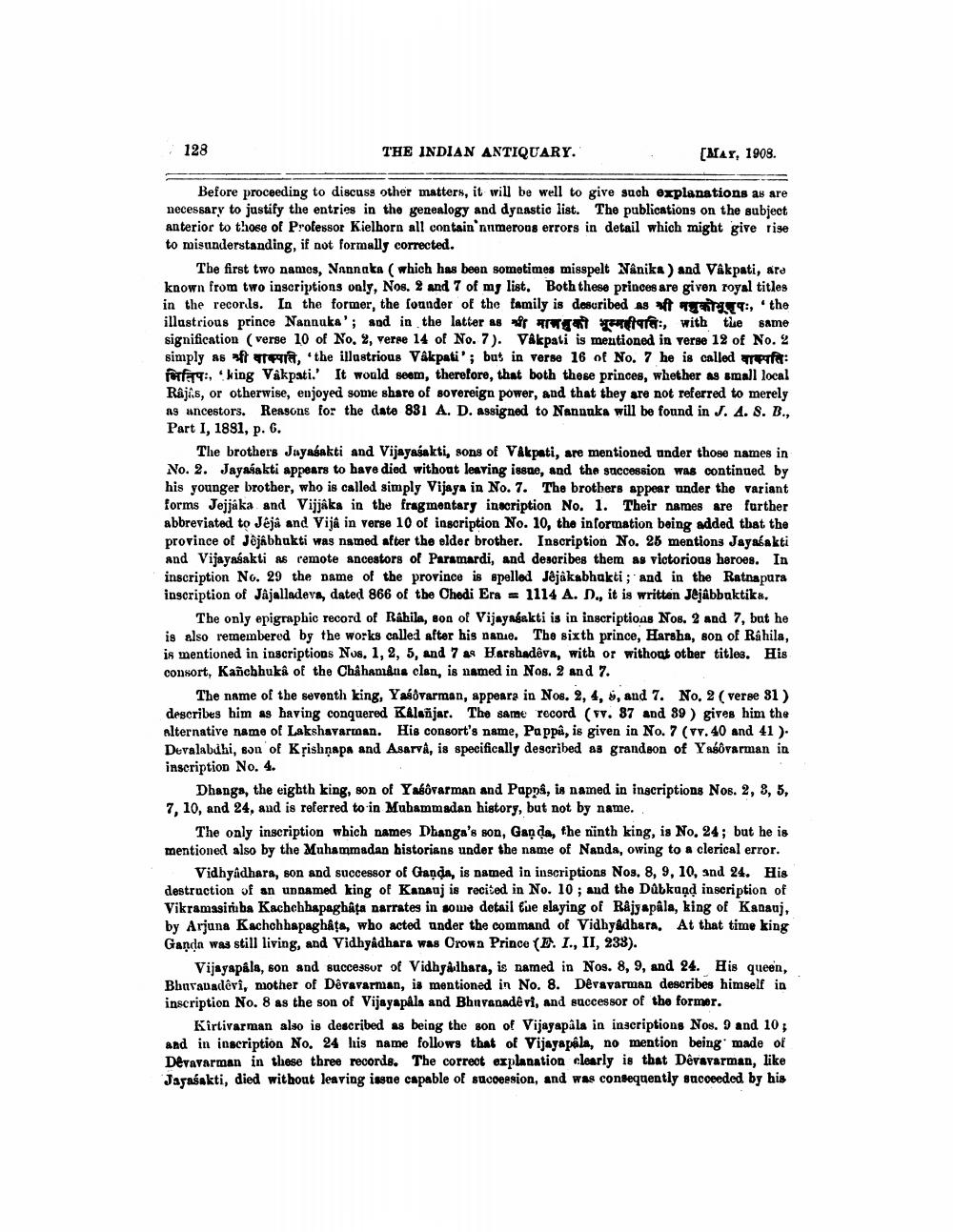________________
128
THE INDIAN ANTIQUARY.
[MAY, 1908.
Before proceeding to discuss other matters, it will be well to give such explanations as are necessary to justify the entries in the genealogy and dynastic list. The publications on the subject Anterior to those of Professor Kielhorn all contain numerous errors in detail which might give rise to misunderstanding, if not formally corrected.
The first two names, Nannata (which has been sometimes misspelt Nánika ) and Vakpati, ara known from two inscriptions only, Nos. 2 and 7 of my list. Both these princes are given royal titles in the recor.ls. In the former, the founder of the family is described as *
:, the illustrious prince Nannuka'; and in the latter as vir Arwaterfra, with the same signification (verse 10 of No. 2, verse 14 of No. 7). Våkpati is mentioned in verse 12 of No. 2 simply as eft pra, the illustrious Vakpati'; but in verse 16 of No. 7 he is called ft: fo , king Våkpati.' It would seem, therefore, that both these princes, whether as small local Rajas, or otherwise, enjoyed some share of sovereign power, and that they are not referred to merely as ancestors. Reasons for the date 831 A. D. assigned to Nannaka will be found in J. A. 8. B., Part I, 1881, p. 6.
The brothers Juyasakti and Vijayasakti, sons of Vakpati, are mentioned under those names in No. 2. Jayasakti appears to have died without leaving issue, and the succession was continued by his younger brother, who is called simply Vijaya in No. 7. The brothers appear under the variant forms Jejjáka and Vijjậka in the fragmentary inscription No. 1. Their names are further abbreviated to Jéjà and VijA in verse 10 of inscription No. 10, the information being added that the province of Jējabhukti was named after the elder brother. Inscription No. 26 mentions Jayabakti and Vijayasakti As remote ancestors of Paramardi, and describes them as victorious heroes. In inscription No. 29 the name of the province is spelled Jejakabhakti ; and in the Ratnapura inscription of Jâjalladeva, dated 866 of the Chedi Era = 1114 A. N., it is written Jéjábbaktika.
The only epigraphic record of Rahila, son of Vijayabakti is in inscriptions Nos. 2 and 7, bat he is also remembered by the works called after his nance. The sixth prince, Harsha, son of Rahila, is mentioned in inscriptions Nos. 1, 2, 5, and 7 as Harshadêve, with or without other titles. His consort, Kanchhuka of the Chåhamdna clan, is named in Nos. 2 and 7.
The name of the seventh king, Yaśðvarman, appeara in Nos. 2, 4, 5, and 7. No. 2 (verse 81 ) describes him as having conquered Kileñjar. The same record (vv. 87 and 89 ) gives him the alternative name of Lakshavarman. His consort's name, Pappa, is given in No. 7 (vv. 40 and 41 ). Devalabdhi, son of Krishnapa and Asarva, is specifically described as grandson of Yasovarman in inscription No. 4.
Dhange, the eighth king, son of Yakovarman and Pappa, is named in inscriptions Nos. 2, 8, 5, 7, 10, and 24, and is referred to in Muhammadan history, but not by name.
The only inscription which names Dhanga's son, Gaq da, the ninth king, is No. 24; but he is mentioned also by the Muhammadan bistorians under the name of Nanda, owing to a clerical error.
Vidhyadhara, son and successor of Ganda, is named in inscriptions Nos, 8, 9, 10, and 24. His destruction of an unnamed king of Kanauj is recited in No. 10 ; and the Dubkaad inscription of Vikramasituba Kachchhapaghata narrates in some detail fue elaying of Rajyapala, king of Kanauj, by Arjuna Kachchhapaghate, who acted under the command of Vidhyadhara. At that time king Ganda was still living, and Vidhyadhara was Crown Prince (E. I., II, 233).
Vijayapala, son and successor of Vidhyalbara, is named in Nos. 8, 9, and 24. His queen, Bhavanadevi, mother of Dêvavarman, is mentioned in No. 8. Dévavarman describes himself in inscription No. 8 as the son of Vijayapála and Bhuvanadevi, and successor of the former.
Kirtivarman also is described as being the son of Vijayapila in inscriptions Nos. 9 and 10; and in inscription No. 24 his name follows that of Vijayapala, no mention being made of Dévavarman in these three records. The correct explanation clearly is that Dévavarman, like Jayasakti, died without leaving issue capable of sucoeesion, and was consequently succeeded by his




